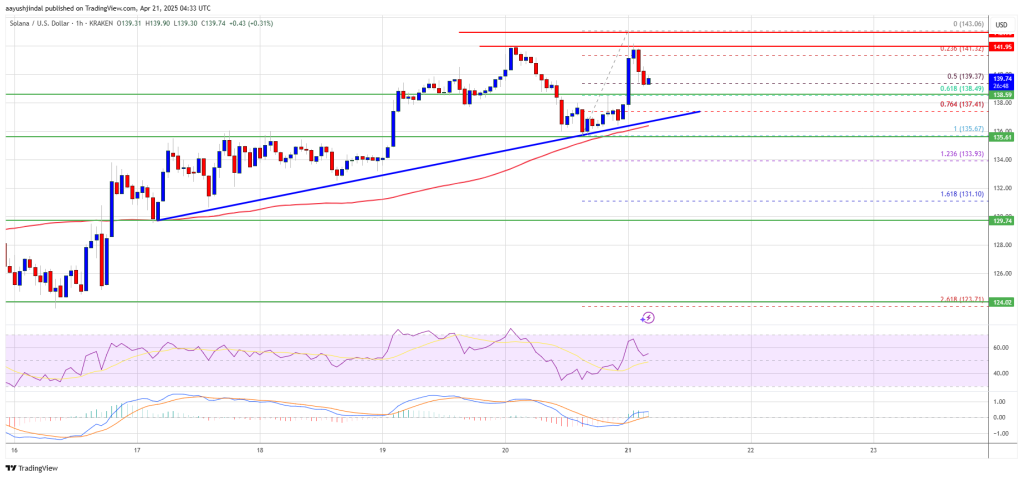Market
Fourth-Largest Swiss Bank Offers Bitcoin


BeInCrypto’s comprehensive Europe Crypto Roundup covers the latest news and trends shaping the continent’s crypto landscape. With reporters across key markets like Germany, France, and the UK, we provide in-depth insights into evolving regulatory environment, adoption rates, major industry events, and market movements.
This week’s roundup highlights Zürcher Kantonalbank’s new crypto service, the signing of the world’s first international AI treaty by the UK, EU, and US, along with other key stories.
German Police Issues Warning About New Bitcoin Scam
The Bavarian State Office of Criminal Investigation (LKA Bayern) has issued a warning about a new crypto fraud. Scammers have been leaving plastic bags around Munich with fake Bitcoin account access codes and payment receipts.
The scam involves eye-catching bags left in public areas like streets and park benches. Inside, victims find a receipt labeled “Bitcoin,” claiming to be worth 10,000 euros, along with a paper wallet — a slip of paper containing data for a crypto wallet, including a QR code.
Scanning the QR code redirects victims to a fake website that promises a payout in exchange for a 3% fee. However, the payment doesn’t go through, causing the person to lose money. Victims may attempt the process multiple times, compounding their losses.
Read more: 15 Most Common Crypto Scams To Look Out For
The LKA Bayern spokesperson warned that victims could unknowingly face legal repercussions. Scanning the QR code alone could be viewed as an attempt to fraudulently obtain someone else’s money, potentially resulting in charges of attempted fraud. Authorities will evaluate each case individually, but they recommend turning the bags in to the police immediately.
Investigators have not yet identified any suspects, and scammers seem to be distributing the paper wallets randomly in high-traffic areas, without a clear pattern. Authorities urge the public to remain cautious and report any suspicious findings to local law enforcement.
Switzerland’s Fourth-Largest Bank Launches New Crypto Service
Zürcher Kantonalbank (ZKB), Switzerland’s fourth-largest bank, has introduced a new service allowing retail customers to buy, sell, and hold Bitcoin and Ethereum. This offering is made possible through a collaboration with Crypto Finance, a digital assets broker owned by Deutsche Börse. Customers can access BTC and ETH via ZKB’s Mobile App, eBanking platform, and other existing channels, the bank announced in a press release on Wednesday.
Switzerland has long been a leader in the digital asset space, with many financial institutions providing cryptocurrency trading services. ZKB is no newcomer to crypto market. In 2021, the bank was involved in issuing the world’s first digital bond on Switzerland’s SIX Digital Exchange (SDX).
“When it comes to cryptocurrencies, Zürcher Kantonalbank takes on the critical function of securely storing the private keys,” said Alexandra Scriba, ZKB’s head of institutional clients and Multinationals. “Customers and third-party banks do not need their own wallet and therefore do not have to worry about storing their own private keys. Zürcher Kantonalbank takes care of both.”
Read more: Crypto vs. Banking: Which Is a Smarter Choice?
This new service also allows other Swiss banks to offer cryptocurrency trading and custody to their clients. Thurgauer Kantonalbank is the first partner bank to adopt the service.
EU, UK, and US Sign World’s First International AI Treaty
The US, EU, and UK signed the world’s first international AI treaty on September 5, aiming to protect human rights and hold AI systems accountable for any harm or discrimination they cause. While the treaty sets important standards, penalties like fines for violations haven’t been introduced yet.
“This Convention is a major step to ensuring that these new technologies can be harnessed without eroding our oldest values, like human rights and the rule of law,” Britain’s justice minister, Shabana Mahmood, said in a statement.
The European Union has already made significant progress in regulating AI with the AI Act, which came into effect in August. This new law will help control the development and use of advanced AI models, especially those with powerful computing capabilities. However, the act has been controversial.
Companies like Meta, which owns Facebook, claim the rules are too strict and are hurting innovation. In fact, Meta has paused the release of some of its latest AI products in Europe due to the complex regulations.
Read more: Top 9 Artificial Intelligence (AI) Cryptocurrencies in 2024
Despite these complaints, the EU is pushing ahead, setting a strong example for AI regulation. The AI Act is seen as a major step in ensuring that AI technologies are developed responsibly and safely, especially as more countries look to regulate this rapidly growing field. European leaders believe their approach will become a global benchmark for balancing technological advancement with ethical and legal protections.
French City Rouen Now Offers Bitcoin Payments for Groceries
France is seeing a growing number of businesses accepting cryptocurrency payments, with the latest addition being a supermarket in Rouen.
This week, Carrefour Express in Rouen made headlines by becoming one of the first supermarkets in France to accept Bitcoin. Customers can pay using the Swiss app Bridge Wallet, similar to Revolut, which facilitates crypto transactions. The system utilizes the Lightning Network to minimize transaction fees, making it fast and cost-effective.
Rouen isn’t alone in embracing crypto payments. While this may be a first for the city, several hundred establishments across France now accept cryptocurrencies. Major hubs like Paris, Nantes, and Lyon lead the way. In Lyon, initiatives like the Comptoir Brunet restaurant and Bitcoin Lyon broker are actively promoting crypto adoption.
Read more: The Best Bitcoin Lightning Network Wallets In 2024
With these developments, crypto payments are becoming more accessible across the country, bringing France closer to a future where digital currencies play a larger role in everyday transactions.
Disclaimer
In adherence to the Trust Project guidelines, BeInCrypto is committed to unbiased, transparent reporting. This news article aims to provide accurate, timely information. However, readers are advised to verify facts independently and consult with a professional before making any decisions based on this content. Please note that our Terms and Conditions, Privacy Policy, and Disclaimers have been updated.
Market
Vitalik Buterin Proposes to Replace EVM with RISC-V

Ethereum (ETH) co-founder Vitalik Buterin has proposed overhauling the blockchain’s smart contract infrastructure by replacing the Ethereum Virtual Machine (EVM) with RISC-V, a widely adopted open-source instruction set architecture.
This shift aims to address one of Ethereum’s key scaling bottlenecks by dramatically improving the efficiency and simplicity of smart contract execution.
Buterin Proposes Ditching EVM for RISC-V
The proposal was detailed in a post on the Ethereum Magicians forum. In it, Buterin suggested that smart contracts could eventually be compiled to RISC-V rather than EVM bytecode.
According to Buterin, this shift addresses long-term scalability challenges. This particularly includes keeping block production competitive and improving zero-knowledge (ZK) EVM-proof efficiency.
“It aims to greatly improve the efficiency of the Ethereum execution layer, resolving one of the primary scaling bottlenecks, and can also greatly improve the execution layer’s simplicity – in fact, it is perhaps the only way to do so,” he wrote.
Current ZK-EVM implementations spend around half of their proving cycles on EVM execution. By switching to a native RISC-V VM, Ethereum could potentially achieve up to 100x efficiency gains.
Importantly, many fundamental aspects of Ethereum’s architecture would remain unchanged, preserving continuity for developers and users. Core abstractions such as accounts, smart contract storage, ETH balances, and cross-contract calls would function exactly as they do today.
Developers would still write contracts in familiar languages like Solidity or Vyper. These would simply be compiled to RISC-V rather than EVM bytecode. Tooling and workflows would remain largely intact, ensuring a smooth transition.
Crucially, the proposal ensures backward compatibility. Existing EVM contracts will remain fully operational and interoperable with new RISC-V contracts.
Buterin outlines several potential implementation paths forward. The first would support both EVM and RISC-V smart contracts natively. The second suggests wrapping EVM contracts to run via an interpreter written in RISC-V. Thus, it would enable a full transition without breaking compatibility.
The third, more modular approach, builds on the second by formally enshrining interpreters as part of the Ethereum protocol. This would allow the EVM and the future virtual machines to be supported in a standardized way.
Buterin stated that the idea is “equally as ambitious as the beam chain effort.”
“The beam chain effort holds great promise for greatly simplifying the consensus layer of Ethereum. But for the execution layer to see similar gains, this kind of radical change may be the only viable path,” Buterin added.
For context, the Ethereum Beam Chain is a redesign of Ethereum’s consensus layer (Beacon Chain). It focuses on faster block times, faster finality, chain snarkification, and quantum resistance. The development will likely begin in 2026.
This proposal fits into Ethereum’s broader vision of modularity, simplicity, and long-term scalability. Previously, BeInCrypto reported on Buterin’s privacy-centric plans for the blockchain.
The proposal focused on integrating privacy-preserving technologies. Moreover, the Pectra upgrade is also nearing, with the launch expected on May 7.
Meanwhile, ETH continues to face market headwinds, trading at March 2023 lows. This year has been quite hard for the altcoin, as it saw a decline of 50.8%. In fact, Ethereum dominance hit a 5-year low last week.

Nonetheless, BeInCrypto data showed a slight recovery over the last 14 days. ETH rose by 6.1%. Over the past day alone, it saw modest gains of 1.7%. At the time of writing, ETH was trading at $1,639.
Disclaimer
In adherence to the Trust Project guidelines, BeInCrypto is committed to unbiased, transparent reporting. This news article aims to provide accurate, timely information. However, readers are advised to verify facts independently and consult with a professional before making any decisions based on this content. Please note that our Terms and Conditions, Privacy Policy, and Disclaimers have been updated.
Market
Solana Rallies Past Bitcoin—Momentum Tilts In Favor of SOL

Solana started a fresh increase from the $120 support zone. SOL price is now consolidating and might climb further above the $142 resistance zone.
- SOL price started a fresh increase above the $125 and $132 levels against the US Dollar.
- The price is now trading above $130 and the 100-hourly simple moving average.
- There is a connecting bullish trend line forming with support at $137 on the hourly chart of the SOL/USD pair (data source from Kraken).
- The pair could start a fresh increase if it clears the $142 resistance zone.
Solana Price Gains Over 5%
Solana price formed a base above the $120 support and started a fresh increase, like Bitcoin and Ethereum. SOL gained pace for a move above the $125 and $132 resistance levels.
The pair even spiked toward the $145 resistance zone. A high was formed at $143.06 and the price is now retreating lower. There was a move below the 23.6% Fib retracement level of the upward move from the $135 swing low to the $143 high.
Solana is now trading above $130 and the 100-hourly simple moving average. There is also a connecting bullish trend line forming with support at $137 on the hourly chart of the SOL/USD pair. The trend line is close to the 76.4% Fib retracement level of the upward move from the $135 swing low to the $143 high.
On the upside, the price is facing resistance near the $142 level. The next major resistance is near the $145 level. The main resistance could be $150. A successful close above the $150 resistance zone could set the pace for another steady increase. The next key resistance is $155. Any more gains might send the price toward the $165 level.
Pullback in SOL?
If SOL fails to rise above the $142 resistance, it could start another decline. Initial support on the downside is near the $138.50 zone. The first major support is near the $137 level and the trend line.
A break below the $137 level might send the price toward the $132 zone. If there is a close below the $132 support, the price could decline toward the $125 support in the near term.
Technical Indicators
Hourly MACD – The MACD for SOL/USD is gaining pace in the bullish zone.
Hourly Hours RSI (Relative Strength Index) – The RSI for SOL/USD is above the 50 level.
Major Support Levels – $137 and $132.
Major Resistance Levels – $142 and $145.
Market
Bitcoin Price Breakout In Progress—Momentum Builds Above Resistance

Reason to trust

Strict editorial policy that focuses on accuracy, relevance, and impartiality
Created by industry experts and meticulously reviewed
The highest standards in reporting and publishing
Strict editorial policy that focuses on accuracy, relevance, and impartiality
Morbi pretium leo et nisl aliquam mollis. Quisque arcu lorem, ultricies quis pellentesque nec, ullamcorper eu odio.
Bitcoin price is slowly moving higher above the $86,500 zone. BTC is gaining pace and might continue higher in the near term.
- Bitcoin found support at $84,200 and started a recovery wave.
- The price is trading above $85,500 and the 100 hourly Simple moving average.
- There was a break above a connecting bearish trend line with resistance at $85,000 on the hourly chart of the BTC/USD pair (data feed from Kraken).
- The pair could start another increase if it clears the $88,000 zone.
Bitcoin Price Eyes Steady Increase
Bitcoin price remained stable above the $83,200 level and started a fresh increase. BTC was able to climb above the $84,200 and $85,000 resistance levels.
There was a break above a connecting bearish trend line with resistance at $85,000 on the hourly chart of the BTC/USD pair. The bulls were able to pump the price above the $86,500 resistance. It even spiked above $87,000. A high is formed near $87,562 and the price might continue to rise unless there is a move below the 23.6% Fib retracement level of the upward move from the $84,007 swing low to the $87,562 high.
Bitcoin price is now trading above $86,500 and the 100 hourly Simple moving average. On the upside, immediate resistance is near the $87,500 level. The first key resistance is near the $88,000 level.

The next key resistance could be $88,800. A close above the $88,800 resistance might send the price further higher. In the stated case, the price could rise and test the $89,500 resistance level. Any more gains might send the price toward the $90,000 level.
Downside Correction In BTC?
If Bitcoin fails to rise above the $88,000 resistance zone, it could start a downside correction. Immediate support on the downside is near the $87,000 level. The first major support is near the $86,750 level.
The next support is now near the $86,000 zone. Any more losses might send the price toward the $85,750 support or the 50% Fib retracement level of the upward move from the $84,007 swing low to the $87,562 high in the near term. The main support sits at $84,850.
Technical indicators:
Hourly MACD – The MACD is now gaining pace in the bullish zone.
Hourly RSI (Relative Strength Index) – The RSI for BTC/USD is now above the 50 level.
Major Support Levels – $86,750, followed by $86,000.
Major Resistance Levels – $87,500 and $88,000.
-

 Market15 hours ago
Market15 hours ago1 Year After Bitcoin Halving: What’s Different This Time?
-

 Ethereum21 hours ago
Ethereum21 hours agoEthereum Consolidates In Symmetrical Triangle: Expert Predicts 17% Price Move
-

 Market21 hours ago
Market21 hours agoToday’s $1K XRP Bag May Become Tomorrow’s Jackpot, Crypto Founder Says
-

 Market19 hours ago
Market19 hours agoMELANIA Crashes to All-Time Low Amid Insiders Continued Sales
-

 Altcoin24 hours ago
Altcoin24 hours agoWhat’s Up With BTC, XRP, ETH?
-

 Market20 hours ago
Market20 hours agoCharles Schwab Plans Spot Crypto Trading Rollout in 2026
-

 Market16 hours ago
Market16 hours agoVOXEL Climbs 200% After Suspected Bitget Bot Glitch
-

 Ethereum23 hours ago
Ethereum23 hours agoEthereum Accumulators At A Crucial Moment: ETH Realized Price Tests Make-Or-Break Point




















